Pistol Heckler und Koch P7
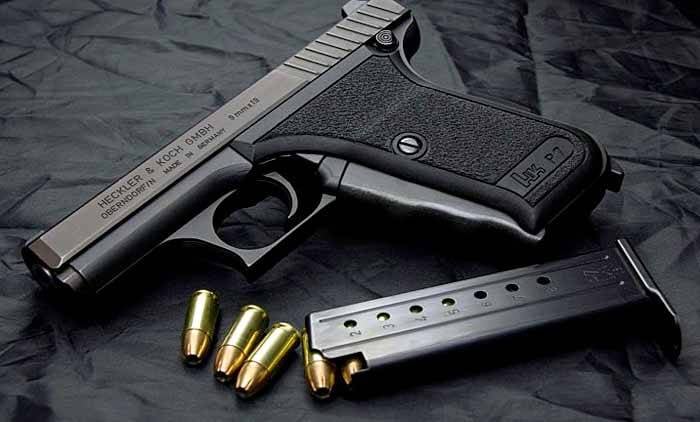
Not very favorably affects the fact that the requirements for new weapons are usually too high, and sometimes even incompatible with the laws of physics. Exaggerating, usually the military wants the new machine gun itself to run, shoot at the enemy, and with this it was not yet more difficult to build an old weapon, and in production it was cheaper.
And if we add to this all the costs of complete retooling, retraining, finalizing the structure at the beginning of mass production, and, God forbid, switching to a new ammunition, then it becomes completely incomprehensible how miraculously a weapon with a new design enters the army or law enforcement agencies.
In other words, if you look for interesting design solutions in firearms, then you need to look for them in experimental, non-mass-produced samples. But there are exceptions, when a truly unusual sample gets not only into the series, but also becomes adopted.
One such exception is the gun of the German company Heckler und Koch P7. This gun stands out not only for its not quite ordinary appearance, but also for the automation system used in it, as well as for the realization of the safety of handling weapons. The solutions that the designers used in this gun are not something new, but they are very rarely found even in experimental samples, since they have negative aspects in addition to their positive sides. Nevertheless, the pistol is not only mass-produced, but is still in service and even participated in the competition for a new pistol for the US Army, losing to Beretta.
Но обо всем по порядку.
History Heckler und Koch P7 development and distribution
The main reason for the appearance of the P7 pistol was the urgent need to replace the weapons of law enforcement agencies in Germany, which were armed with obsolete Walther P38. The main requirement for the new weapon was the ability to quickly bring the gun into combat readiness, while maintaining its safe handling and ease of use. Designers of the company Walther began to work on a weapon with a common system of automation and firing mechanism, resulting in a fairly good pistol, which by its characteristics was identical to modern samples of the time. The designers of Heckler und Koch chose a more complicated way, having implemented solutions in their gun that were not previously common, but were very promising.
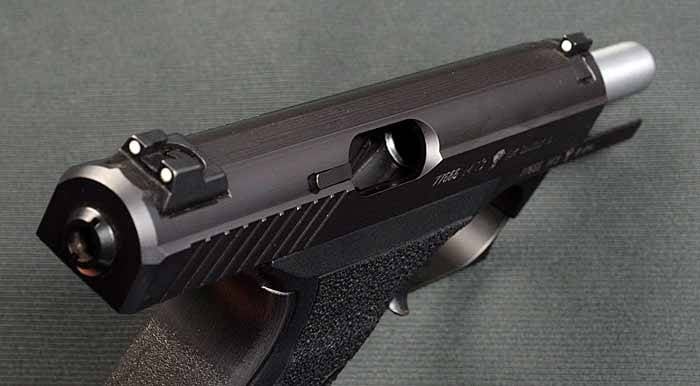
The basis of the new weapon was taken automation scheme with locking the bore gunpowder gases through the piston. Such a solution has significantly increased the resource of new weapons. The safety of handling the pistol was ensured by the most reliable method known to all - the drummer's platoon was carried out separately, while the trigger mechanism of the pistol was of single action, that is, the force when pressing the trigger was minimal, which combined with a convenient handle made the gun fairly accurate. Below, we will dwell on both nodes in more detail.
It is impossible to get around the fact that in the production of a new pistol it was not much more expensive than other modern representatives of this class of this weapon, since, while one node became more complicated, the other simplified.
The combination of characteristics and the readiness of the design of weapons for mass production led to the fact that the Heckler und Koch pistol became the new main weapon of the German police in 1979, then the pistol was designated as Р7, previously it was called PSP.
The successful combination of the characteristics of the new weapons and the already established production allowed the German company to bring the pistol to the world market, although it did get there in a slightly modified version.
In 1981, the gun was slightly upgraded, replacing the magazine latch at the bottom of the pistol grip, with the button at the safety bracket, which increased the speed at which the magazine was replaced. For ease of use of the weapon in gloves, the safety bracket was increased, and an insert was added to protect the index finger of the shooter when the weapon overheated from prolonged and frequent firing. The updated pistol received the designation Р7М8, it is in this form that the pistol is produced to this day.
In 1982, the designers again modernized the weapon, but did not replace the previous model with it. The new version received an extended-capacity magazine of 13 rounds, while not only the weapon magazine was modernized, but also the pistol grip, so the magazines are not interchangeable. In 1991, for the US market, where the .40 cartridge is popular, S&W developed another version of the pistol. There was also an attempt to create a pistol chambered for .45АСР, but an additional unit had to be introduced into the design to compensate for recoil and ensure the normal operation of the automation system in the form of an oil damper. This not only increased the cost of the pistol, but also reduced its reliability at low and high temperatures, so the serial production of this option was abandoned.
At the moment, the P7 pistol is in service with law enforcement agencies in the US state of New Jersey, as well as with the army and police in Greece, where it is manufactured under license. In addition, the gun is offered in the civilian arms market, which is still in demand.
Heckler und Koch P7 pistol design
As noted earlier, the Heckler und Kock pistol does not have new ideas in its design, but it uses bold and original solutions that were not previously distributed, and even now have not found wide application.
The main feature of the weapon is its automation system. Powder gases are used to close the bore. In our usual use of powder gases for automatic weapon operation, powder gases from the barrel bore are used for unlocking, but due to the high pressure at the moment of burning the powder, the resulting mixture of gases blocks the casing-shutter preventing it from rolling back.
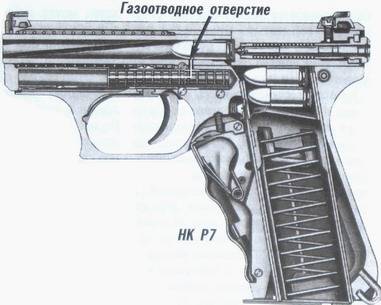
It is implemented as follows. Part of the powder gases from the barrel bore is discharged into the cylinder under the barrel into which the piston is connected, which is connected to the casing by the gate. Thus, the pressure in the bore with the same force puts pressure on the bottom of the sleeve, trying to push the cover-slide back through it and onto the piston without letting the cover-slide move. After the bullet leaves the barrel, the pressure of the powder gases drops and the casing of the shutter begins to move back, extracting the spent cartridge case.
In order for this system to work without fail it is necessary to take into account many factors, including even the diameter of the hole for removal of powder gases. The fact that the designers managed not only to make the shutter remain motionless, but at the right moment, which lasts thousandths of a second, to set it in motion worthy of respect.
No less interesting is the trigger mechanism of the pistol. When the gun was only designed for the German police, one of the main requirements for this weapon was the ability to immediately fire a shot and remove the holster. That is, the cartridge was already in the chamber. This requirement left a definite imprint on the safety of the handling of weapons. The logical solution to this issue would be the introduction of a double-action firing mechanism into the pistol's design, in order for the trigger to be activated when the trigger is pressed for the first time. This solution had one major drawback - the force of pressing the trigger would be large enough, which could affect the accuracy of the shot. If the trigger mechanism would have only double action, then a great effort of pressing the trigger would be necessary before each shot. In the case, if the trigger mechanism remained in the cocked position after each rollback of the housing and bolt back, then the problem of a smooth descent would have to be solved, and these are additional details in the gun, and hence its higher cost.
The solution, which was used by the designers of the Р7 pistol, is much more original, although the opposite is not new. The trigger mechanism of a single-action pistol, that is, before firing, you need to bring trigger in combat position. The trigger is pulled using the large key at the front of the handle to hold.
In practice, this solution works as follows. In the stowed position, the pistol's trigger mechanism is not in the cocked state. When the shooter grabs the handle of the weapon, he presses a key on it. Pressing the key sets the drummer in motion, which is locked in the cocked position. After pressing the trigger there is a breakdown of the firing pin and a shot. When the shutter casing performs its recharge cycle, the drummer is again in the cocked position and the next shot can be fired. If the shooter releases the handle of the weapon, the spring-loaded key is pressed, which leads to the safe descent of the drummer.
This design of the gun made it possible not only to make it completely safe to use, but also to abandon the fuse in the usual sense of the word. For the sake of justice, it is worth noting that copies of the Р7 pistol, which are produced in Mexico, can boast of having a fuse switch, although it is not clear why you need it.
Many owners of these weapons point out that after a long shooting, the hand begins to tire more strongly in comparison with other pistols, but here you need to understand that this is not about a dozen shots. That is, the weapon creates discomfort during prolonged training, and in combat use this drawback will be absent.
At this unusual solutions in the design of the gun Р7 not over. In addition to all the above, the slide latch is of interest. The implementation of the slide delay is quite standard, but the location of the control button raises questions. Usually the lever or the shutter delay button is positioned above the safety bracket with an offset to the shooter, in the Р7 pistol this place is empty. But there is a small button on the left side of the gun behind the handle. This is done to speed up the change of weapons store. With this arrangement, the removal from the slide delay can be made immediately after the new magazine is inserted into the gun, which in principle can be done with the classic arrangement of this control. However, the button is located in an unusual place, although it is, by and large, a matter of habit and finger length.
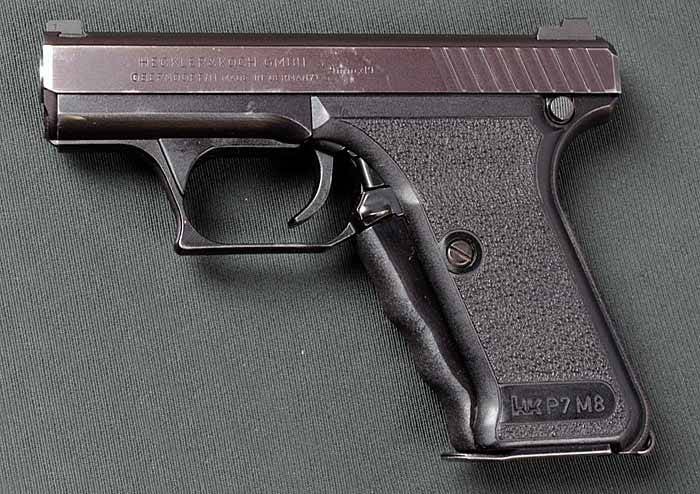
When using the automation system with the braking of the housing-shutter powder gases significantly increases the time that must be spent on cleaning and maintenance of weapons. In order to at least partially reduce this time, the designers used a polygonal-cut barrel in the pistol. This solution allowed not only to simplify the cleaning of the barrel bore, but also increased the accuracy of the pistol compared to weapons with classic rifling in the barrel, other things being equal. The barrel itself is planted low enough, which, in turn, affects the accuracy and comfort of firing a P7 pistol.
TTX pistol Heckler und Koch P7
Since the P7 pistol exists in three basic versions, the characteristics below will apply only to them. Options weapons that are produced in Greece and Mexico will not be fundamentally different from the original.
The gun with the designation Р7М8 (or simply Р7) has a mass of 780 grams without cartridges. His shop holds 8 cartridges 9x19. The length of the gun 171 millimeter with the length of the barrel 105 millimeters.
The weapon version with the 13 magazine of increased capacity for 9x19 cartridges weighs slightly more - 850 gram without cartridges. The increase in the thickness of the handle of the weapon somehow affected the length of the pistol, its length 175 millimeters with the same barrel length 105 millimeters.
A much heavier version of the pistol chambered for .40S & W. A more powerful cartridge required not just the replacement of the barrel and the magazine of the weapon, but the processing of almost all the pistol components. As a result, the P7M10 weighs as much as 1200 grams without cartridges, which is a lot, even taking into account the ammunition used. The length of the weapon is equal to 175 millimeters with a barrel length of 105 millimeters. The magazine holds 10 rounds.
It is also worth mentioning the existence of a pistol chambered for .380ACP, its characteristics are similar to Р7М8.
Pros and cons of a Heckler und Koch P7 pistol
The main advantage of this gun is its complete security with constant readiness for use. High accuracy, the absence of additional controls, structural reliability is also clearly not a minus. The design of the weapon itself for many will also be an indisputable advantage of this gun, since it is really interesting.
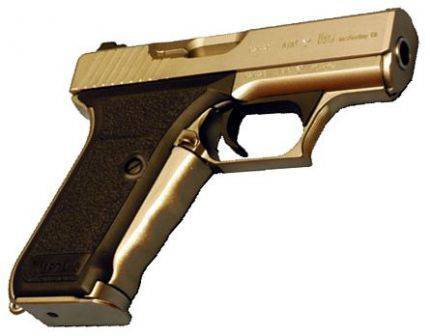
The cons of this weapon is also enough, and although they are insignificant, they are present. First of all, it is necessary to note the difficulty of servicing the weapon and the time spent on it.
It is often noted that one of the main drawbacks is the heating of the cylinder of the locking piston, which creates a certain discomfort during long-term firing, even despite the heat-insulating insert. It seems to be a significant drawback, but this is a gun, not a machine gun, and the fact that people shoot hundreds of rounds of ammunition out of it, and then complain about the heating of the frame, well, somehow strange. Other pistols also do not stay cold after such use. You can also treat complaints of fatigue in the hand during long shooting.
If we compare this gun with modern weapon models, we can also single out the small capacity of the store with a separate drawback, even in the Р7М13 variant.
The price of the gun also refers to the minuses, for comparison at cost, the second-hand P7 stands as two Glox 17, but, nevertheless, P7 is bought, used and it is still in service.
Well, it is impossible not to mention the location of the shutter delay key, which, in my opinion, is the “main” disadvantage of this gun.
Conclusion
If you give an estimate of the characteristics of the P7 pistol, then this is certainly an interesting and not quite ordinary weapon. On the totality of its characteristics, it surpasses the younger modern pistols, which, for the most part, resemble each other like two drops of water.
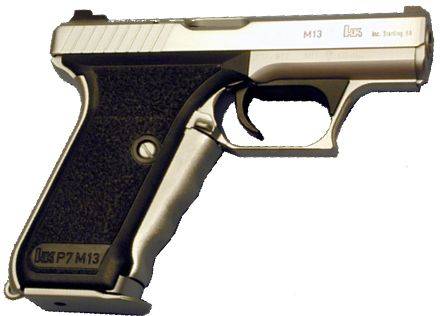
The sad thing is that manufacturers are fixated on the same decisions and do not even go to the minimum risk, fearing to deviate from what is now accepted in the arms world. Р7 is a vivid example of the fact that in order to create a unique and interesting thing it is not necessary to look for something new, it is enough to take something that could not be realized before and brought to the ideal.
Of course, the P7 has its drawbacks, many of which seem substantial enough, but there is not a single perfect pistol in which it would be impossible to find any weak points.
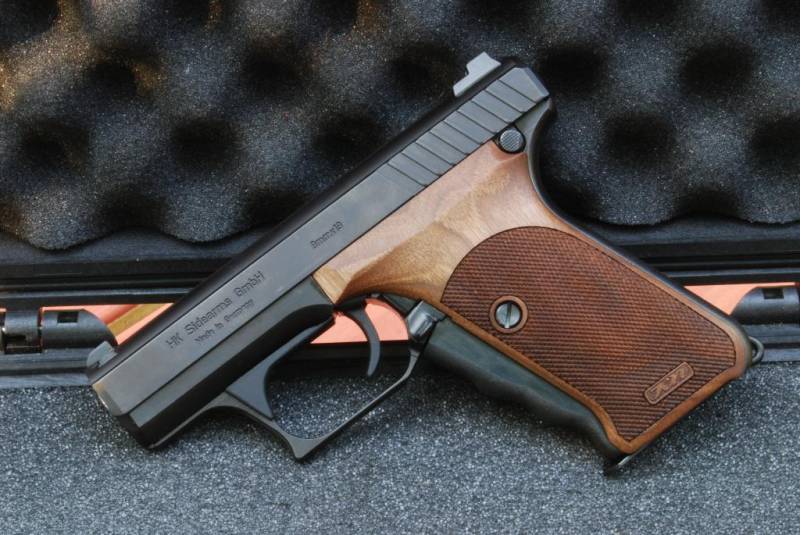
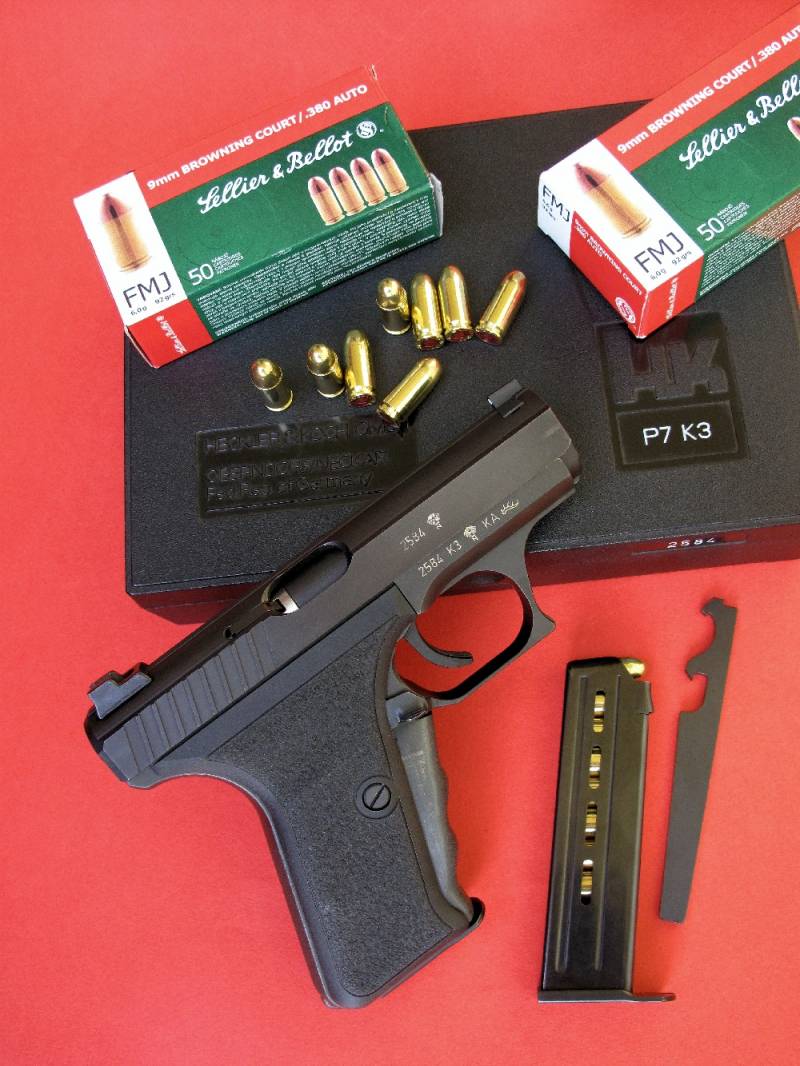
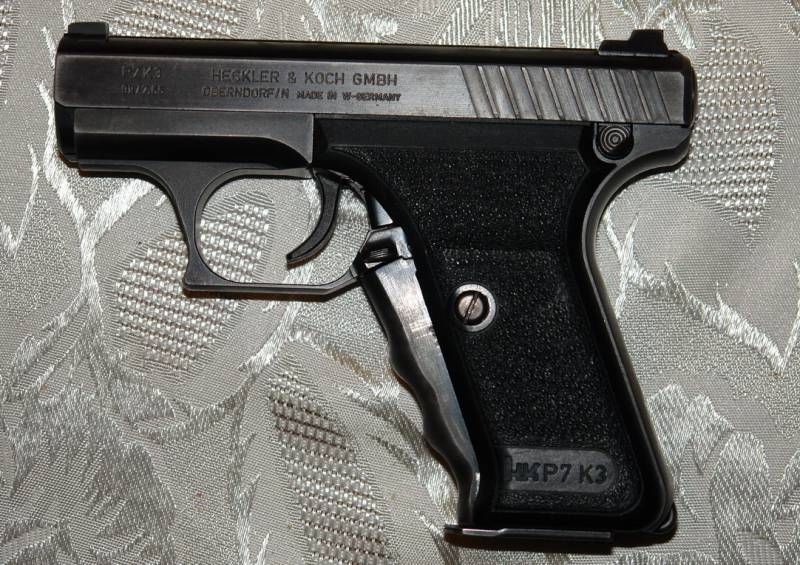
Information